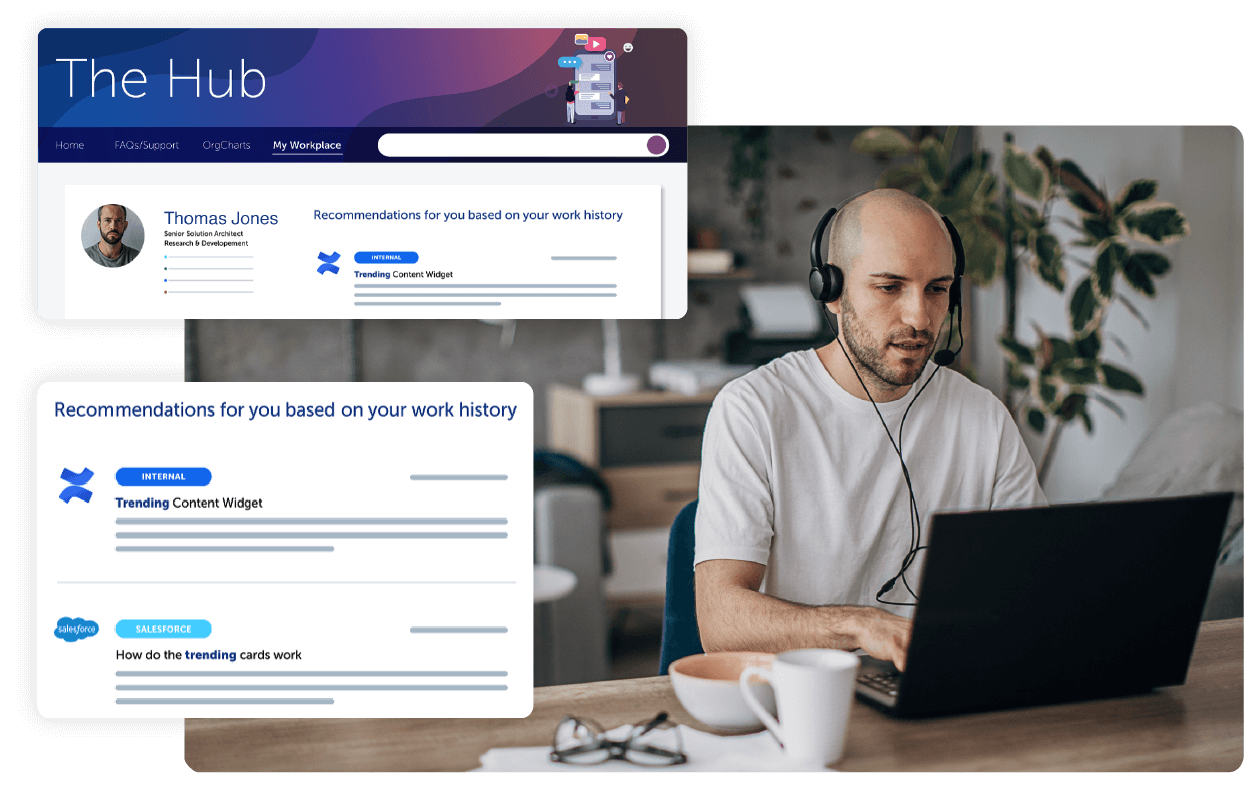The line between the digital and physical workplace continues to blur. Digital technology has become essential as the COVID-19 pandemic forced businesses to employ remote workers, and will continue to be important as hybrid work models start to take remote works’ place.
What exactly composes a digital workplace? Whether a confluence of digital tools software and apps like Microsoft Teams, Slack, and Google drive, your company’s intranet, or something else altogether, many across the world consider it fundamental to their work life and their employee productivity. According to a recent Digital Workplace Experience survey, 74% of respondents identified the digital workplace as an important aspect of any modern company.
So, it’s worth our while to dig a little deeper.
The truth is, all of the abovementioned interpretations are right—but digital workspaces are a great example of the whole being greater than the sum of its parts. Digital workplaces are more than just tools—they’re digital employee experiences. They’re all about your organization’s people: how they work, how they collaborate, how they innovate, how they overcome challenges and bring new ideas to life. A digital workplace is a blend of your people, processes, and technology, all of which need to be aligned to achieve positive business outcomes.
The backbone of any successful digital workplace—and any successful employee experience—is relevance. True collaboration, communication, and proficiency depend on contextually relevant information for every constituent. In this article, we’ll explore what proficiency looks like, common roadblocks to success, and how you can overcome these mistakes to create a successful digital workplace of your own.

Getting a Digital Workplace Strategy in Place
According to a presentation done by Bob Hafner at the 2017 Gartner Digital Workplace Summit, effective digital workplaces boost “employee agility and engagement through a more consumerized work environment.” With it, employees should be able to leverage each other’s knowledge and collaborate on shared projects more easily with a greater rate of success.
In that sense, a digital employee experience enables “results-oriented” work—your employees spend less time on administrative tasks such as finding information or validating results and are instead focused on the most important parts of their jobs, whether that’s making decisions or finalizing assets.
AI-powered search and recommendations are a critical component of the digital workplace as it ensures that your employees are empowered to make the best decisions by having access to the most relevant information according to their role, context, and intent of their query. To encourage and increase employee adoption, the digital workplace platform that supports your workplace should be consumerized and easy-to-use. This helps to ensure that your employees aren’t distracted by a steep learning curve or with intermittent problems.
The closer your technology stack looks and feels like technology they already engage with, the more your employees will enjoy interacting it, enhancing cross-functional internal communication, strengthening team collaboration and improving overall operational efficiency.
6 Common Roadblocks to Success
Even with the best intentions and deepest desires for an efficient digital workplace, there are common roadblocks that often prevent organizations’ success.
- Your company knowledge is trapped in disparate silos
- There is no easy way to share information between departments
- Employees are rewarded for hoarding knowledge and acknowledged for being the “go to” person
- There is no clearly defined process on how to store information
- There is an inefficient division of labor when it comes to creating and storing information
- You do not have a knowledge sharing culture
Symptoms of an inefficient digital workplace take many forms, but they always boil down to the same thing: irrelevance. Misalignment and eventual breakdown of your digital workplace will occur if relevance is not a priority. For your people, processes, and technology to seamlessly work together, relevant experiences must be your organization’s guiding principle.
Employees Bear the Brunt of Bad Digital Experiences
The single biggest problem that we see in enterprises today is their inability to deliver relevance to their customers, employees, and partners. Employees are often the ones who suffer most, as customers and partners tend to be prioritized.
However, not offering a comparable experience internally as you do externally can have a significant negative impact on your bottom line, resulting in high churn and costly training, low employee engagement, and stunted innovation.
Your digital workplace drives employee proficiency and therefore has the potential to drastically increase your bottom line, so it shouldn’t be considered an afterthought. With access to your company’s collective knowledge, your employees can better and more quickly help your customers—from your support center, to your marketing efforts, to product development, straight through to sales—greatly impacting customer satisfaction, retention, and lifetime value.
With AI and machine learning, repetitive tasks can be automated, freeing your employees time to work on more complex issues. This isn’t only empowering for them, it ensures you’re getting the most from them while they’re on the clock. Access to company knowledge and a platform to collaborate on ideas has also proven to be the catalyst for new products and services that open additional streams of revenue.

Tips for Creating a Successful Digital Workplace
What truly sets an effective digital workplace apart is company culture. Your organization’s approach to establishing relevance and sharing knowledge, not merely information or assets, will fundamentally change the way your employees interact with each other and your customers.
Your relevance transformation begins with instilling a cultural commitment to collaboration. Rather than supporting hoarding-like behavior, employees should be rewarded for sharing their knowledge and capturing information so their peers can also benefit from it. Given this may not come as second nature, managers, leaders, and key stakeholders in the organization have a responsibility to actively get collaborative buy-in of their teams and peers and create opportunities for it to happen.
Success isn’t bred in a vacuum—that’s why it’s crucial to eliminate information silos once and for all. Unifying your company knowledge into a single index is the best way to facilitate quick access to information. With the added layer of AI-powered search and relevance, you can ensure that your employees are getting the most salient information, according to the context and intent of their query, at every interaction.
Having a process in place, such as KCS®, that easily and intuitively allows employees to share their knowledge with each other will contribute to your sustained success. Establishing process means you should have knowledge management systems, governance frameworks, and best practices in place to help your employees navigate your digital workplace.
What’s the ROI of a Successful Digital Workplace?
There’s a common misconception that creating a successful digital workplace is too much work for not enough pay off. It may not be easy, but with today’s technology it’s more attainable than ever before. What’s more, it is paying dividends for leading organizations which are making it a priority.
For example, with AI-powered search and recommendations, XERO has created a vibrant knowledge sharing and collaborative culture. The company has gained visibility into what content their employees find most useful, has empowered agents with the information they need to autonomously solve complex issues without escalation and successfully personalized the agent experience at scale, resulting in increased agent proficiency and customer satisfaction.
An informed employee is an employee who can make all the difference: whether that is making better decisions, delivering a superior support experience, or being equipped to think innovatively.
The age-old saying is true; knowledge is power… if it is relevant. In short, a successful digital workplace is one that unifies relevance across your organization, equipping your employees to continually evolve and work smarter, together.
To learn how to evaluate the relevance of your digital workplace and the impact of solving the relevance problem for your digital workplace could have on your organization, check out our whitepaper with CMSwire.


